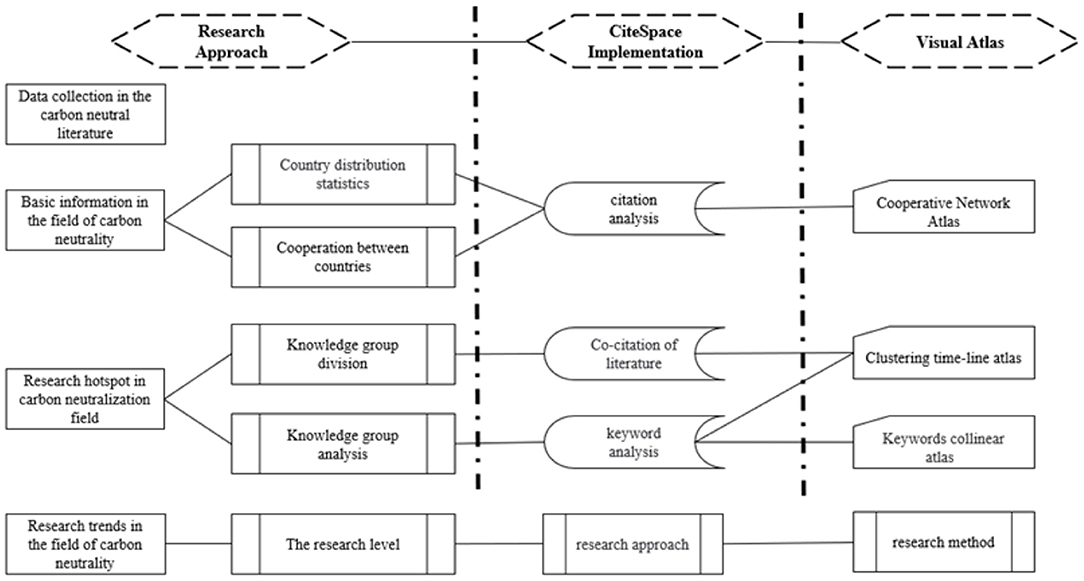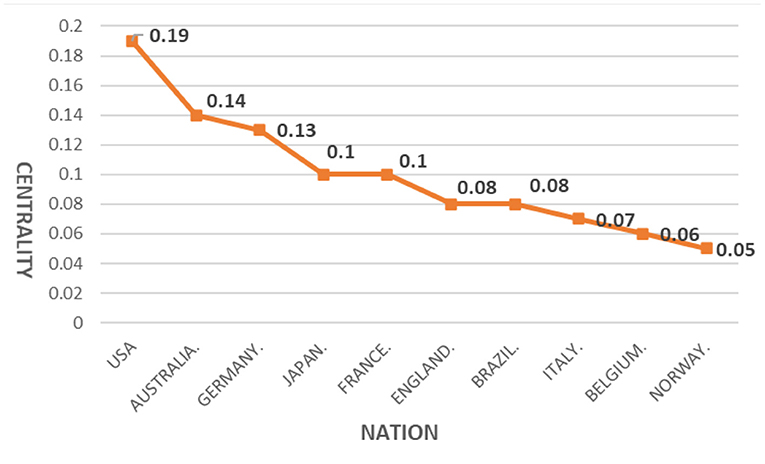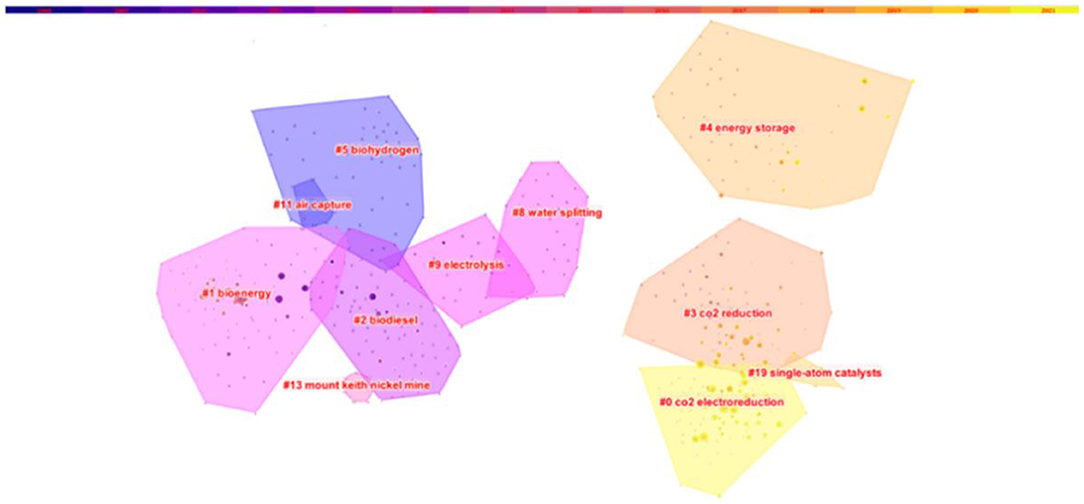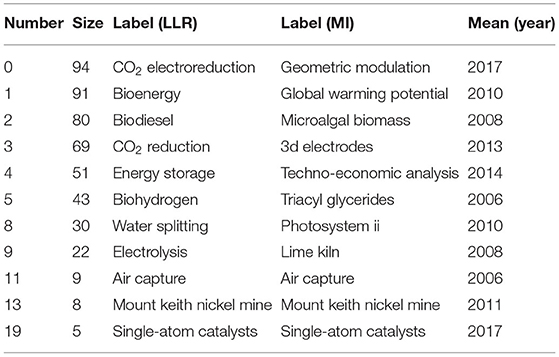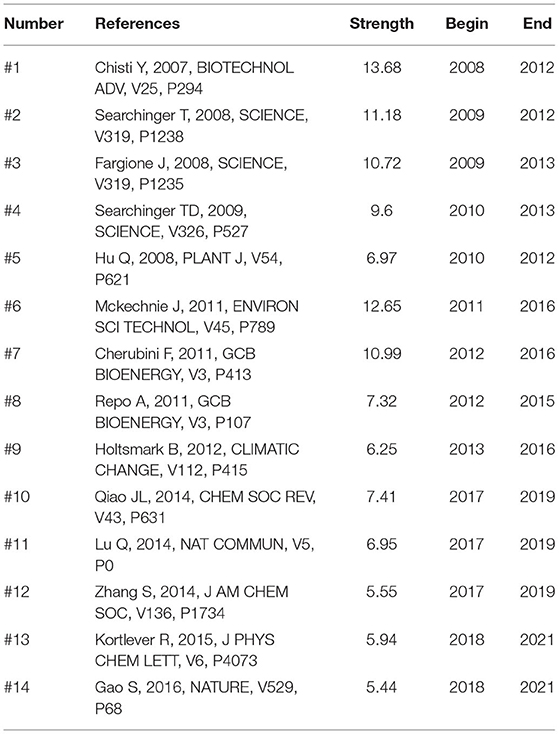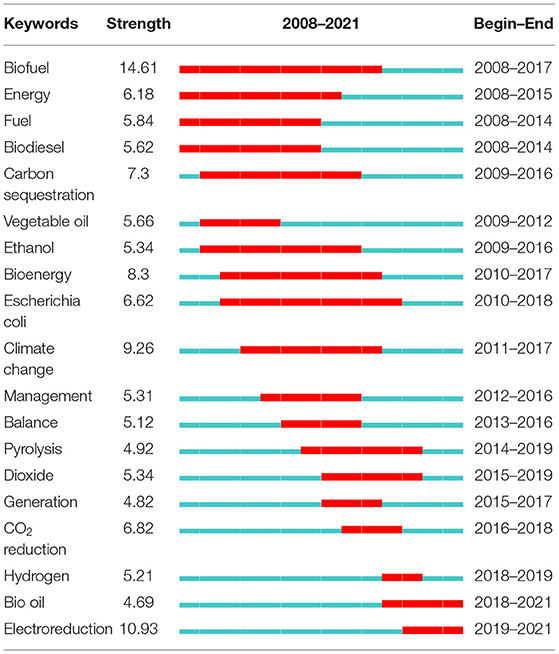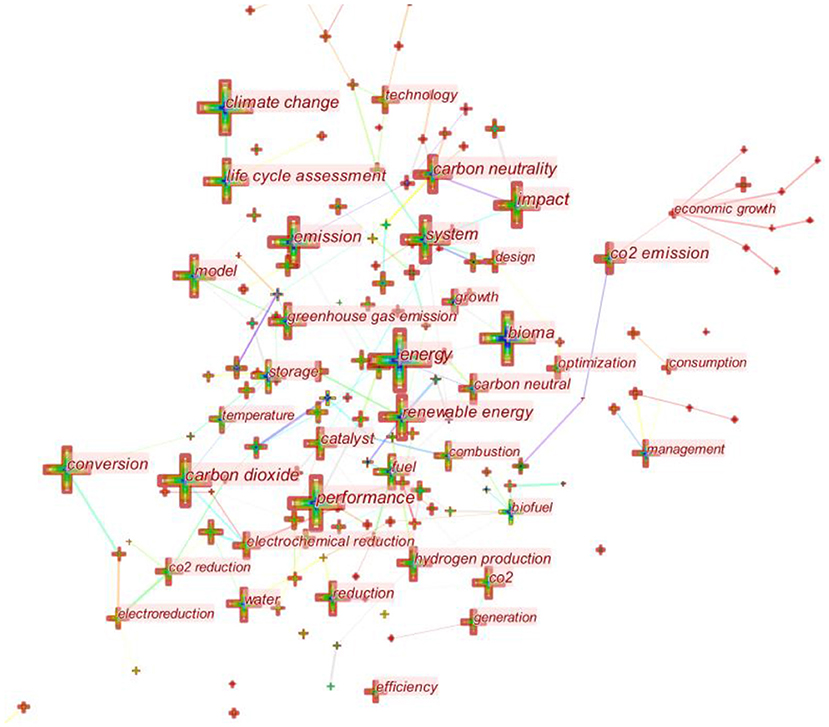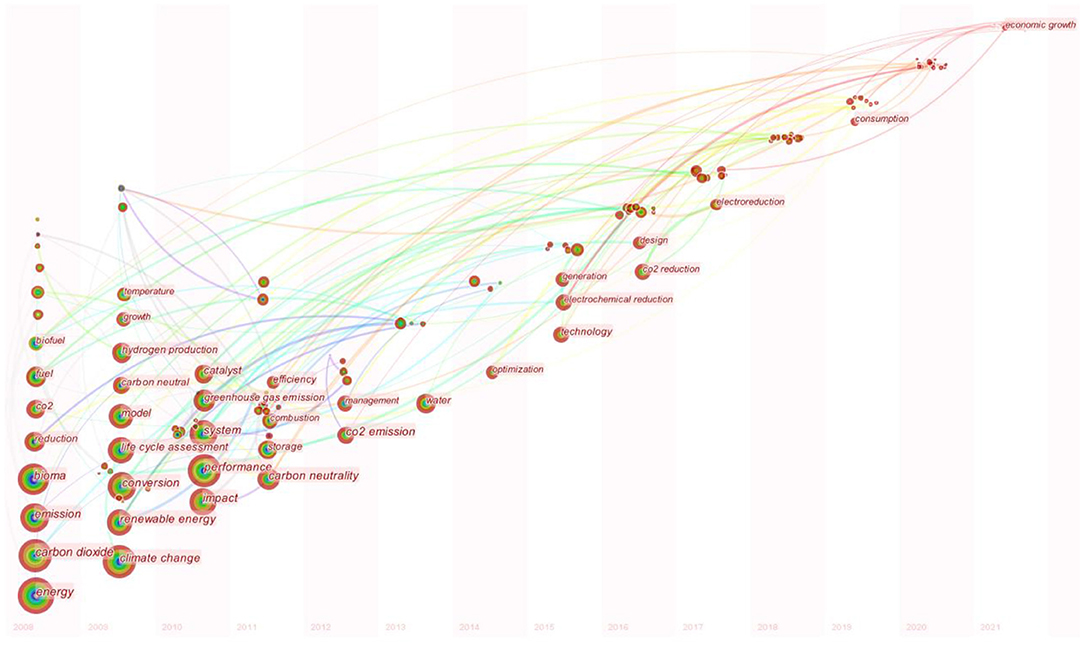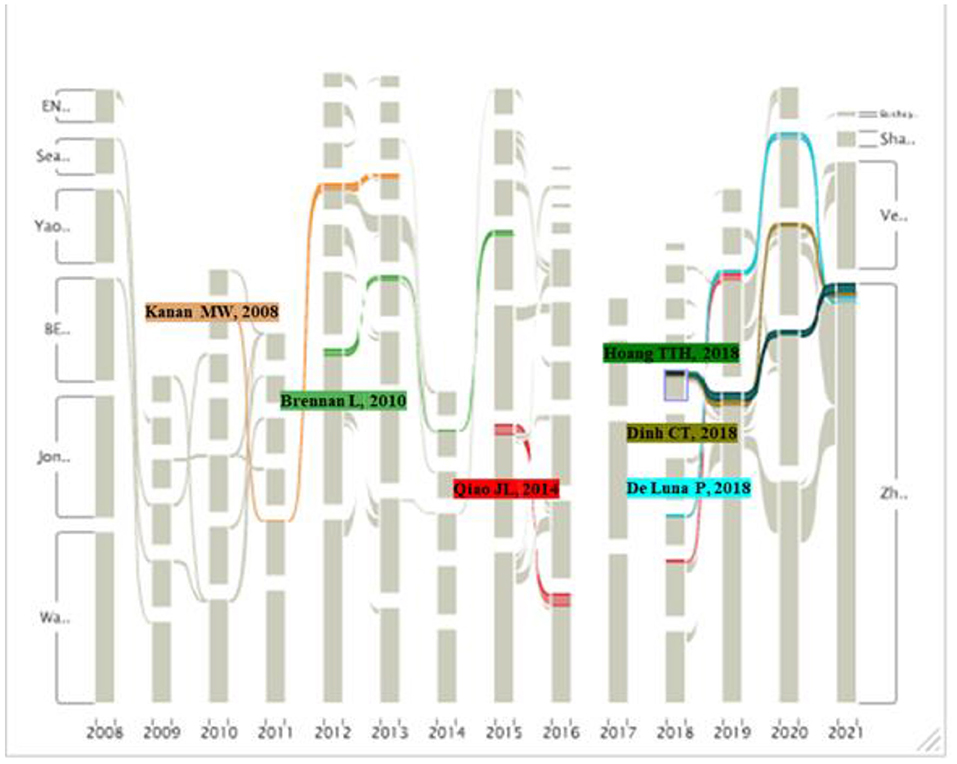- 1School of Management Engineering and E-Business, Zhejiang Gongshang University, Hangzhou, China
- 2School of Foreign Languages, Zhejiang Gongshang University, Hangzhou, China
- 3Contemporary Business and Trade Research Center, Zhejiang Gongshang University, Hangzhou, China
- 4Academy of Zhejiang Culture Industry Innovation and Development, Zhejiang Gongshang University, Hangzhou, China
- 5School of Business Administration, Zhejiang Gongshang University, Hangzhou, China
The visual analysis of carbon neutrality research can help better understand the development of the research field and explore the difficulties and hot spots in the research, thus making contributions to “carbon emission reduction,” environmental protection and human health. This paper makes a visual quantitative analysis of 2,819 research papers published in top international journals from 2008 to 2021 in the WOS core database. It is found that China, the United States, Britain, and Germany are leading the way in carbon neutrality research. The research hotspots are mainly divided into three dimensions: (1) biomass energy and the negative effects it might bring; (2) ways and methods of electrochemical reduction of carbon dioxide; (3) catalysts and catalytic environment. The research mainly went through the conceptual period of 1997–2007, the exploration period of bioenergy from 2008 to 2021, the criticized period of bioenergy sources from 2011 to 2013, and the carbon dioxide electroreduction period from 2013 to the present. In the future, the research direction of biomass energy is to find one kind of biomass energy source which can be stored in a low-carbon way, produced in large quantities at a low cost, and will not occupy forestland. The electrolysis of water to produce hydrogen and the synthesis of fuel with CO2 are two major research directions at present, whose aims are to find the suitable catalyst and environment for the reaction. Besides, more research can be done on “carbon neutrality” policies so as to reduce carbon dioxide emissions from the source, develop a low-carbon economy and protect human health.
Introduction
At present, more than 120 countries and regions have put forward the goal of carbon neutrality, which has become one of the common goals of the world. The concept of carbon neutrality was first introduced in 1997 by Future Forests (later renamed Carbon Neutral), a company based in London, UK. It means that households and individuals can offset their carbon emissions by purchasing certified carbon credits for environmental protection purposes. The company also provides carbon reduction services such as afforestation for these users. In 2006, the New Oxford English Dictionary named “carbon neutral” as its word of the year, and the term was then officially added to the dictionary. The dictionary defines it to protect the environment by calculating the amount of carbon dioxide emitted and then absorbing it by planting trees. Then “carbon neutral” began to appear in academic journals. At present, the research on carbon neutrality is mainly divided into four parts: the first is the research on biomass energy, from the initial crop production of biomass fuel to forest wood, and then to microalgae. Microalgae is one of the most suitable bioenergy energy sources at present. Finding suitable sources of biomass energy is the focus of research in this area (1–4); the second is the research on the reduction of carbon dioxide to hydrocarbon fuels, the main paths are carbon dioxide capture, water and carbon dioxide decomposition, and the synthesis of fuels. The current research focus in this field is to find suitable electrocatalysts to achieve high-efficiency synthesis of fuels (5–7); the third is the exploration of new energy sources, such as the use of electrolysis of water to generate hydrogen energy, and the search for suitable photoelectrode materials to convert solar energy (8).
The above research content is about the exploration of the realization path of carbon neutrality, which has certain reference value for the relevant research. But these studies fail to give an overall picture of carbon neutrality research. At present, there are few literature reviews in the field of carbon neutrality, and none of them can directly show the development, research hotspots and future trends of carbon neutrality research. In general, there is a lack of literature on the overall development context and research hotspots in the field of carbon neutrality.
Therefore, this paper uses Citespace and Alluvial Generator as visual measurement soft-wares to carry out the following research from the dimensions of “countries,” “institutions,” “co-citation analysis of literature,” and “co-occurrence of keywords:” (1) research status and cooperative relations in the field of carbon neutrality among various countries; (2) research hotspots and emerging trends in the field of carbon neutrality; (3) the development of carbon neutrality research and the difficulties encountered in the research.
The main contributions of this paper are summarized as follows:
(1) A bibliometrics research framework is designed to provide research methods and visualization approaches for research hotspots, research development, and research trends in different fields.
(2) The international situation of carbon neutrality research is visualized and cooperation among different countries in this field are analyzed to further promote international co-operation in carbon neutrality research.
(3) The visual analysis of research hotspots, research development and research trends of carbon neutrality research is carried out to identify the development trend and some urgent problems in the research, so as to provide suggestions and implications for the future development of carbon neutrality research.
In Section 2, the experimental design of this paper is proposed, including the realization method and the manifestation of the visualization of carbon neutralization research. In Section 3, the hotspots and development of carbon neutralization research are visually analyzed. In Section 4, we present our research conclusions, limitations, and put forward suggestions for the development of carbon neutrality research. Finally, we give our conclusions and future research directions in Section 5.
Research Design
Research Methods
For the quantitative analysis of carbon neutrality research, this paper uses the visualized literature analysis tool CiteSpace developed by Professor Chen Chaomei (9). The literature information on the theme of carbon neutrality is used to draw the scientific knowledge map through citation analysis, co-citation analysis and co-occurrence of keywords. The map is interpreted by the clustering timeline, time zone and co-occurrence map with the help of word frequency, intermediary centrality, and emergent analysis. The development trend of this field can be summarized by exploring the evolution stages, changes of research topics, research hotspots and research frontiers of carbon neutrality research. The analysis of the development of carbon neutrality research combined with CiteSpace technology is shown in Figure 1.
Data Collection
On 13 February 2022, the author selected articles and reviews on the theme of “carbon neutral” and “carbon neutrality” through WoS Core Collection database for data retrieval of unlimited years. Given the reliability of the conclusion, 2,819 valid data were selected by excluding articles with incomplete abstracts and key information or inconsistent themes. Among them, there are 2,392 articles and 427 reviews. Then the titles containing citation information are exported, and the exported data are de-duplicated by CiteSpace 5.8. R3.
Research Results and Analysis
Visual Analysis of Basic Information on Carbon Neutralization Research
In order to explore countries worthy of attention and find leaders to promote carbon neutrality research, this paper uses the cooperation analysis of CiteSpace software to study the influence and cooperation relationships among countries, providing a theoretical basis for the current situation and contribution analysis of carbon neutrality.
CiteSpace is used to carry out visual statistical analysis of 2,819 top journal articles, and the knowledge map of the cooperative relations between high-yielding countries conducting carbon neutrality research is obtained after being adjusted with visualization, as shown in Figure 2. Figure 2 shows a total of 102 nodes and 369 links. The connection strength of links is calculated using cosine distance.
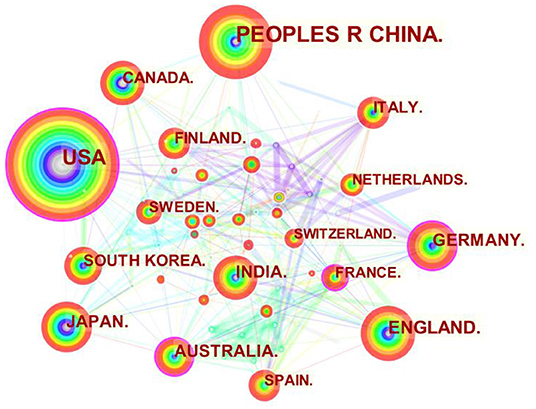
Figure 2. The knowledge map of major partnerships in high-yielding countries conducting carbon neutrality studies.
In Figure 2, a node represents a country, the size of the node represents the number of publications, the width of rings in different colors represents the number of publications in different years, and the years change from far to near as the ring rings change from inside to outside. The link between the nodes represents the cooperative relationship between the two countries, and the width of the link represents the closeness of the cooperative relationship. After sorting out and analyzing the information in Figures 2–4 are obtained, which are used to further analyze the relationship between high-yielding countries in the study of carbon neutrality. The following conclusions are drawn from the study.
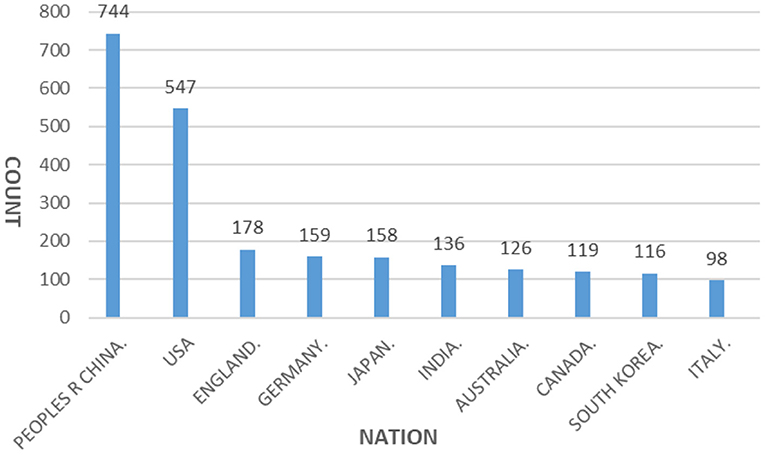
Figure 3. Distribution of the number of published articles in high-yielding countries conducting carbon neutrality studies.
From the perspective of cooperative relations, there is no strong direct cooperative relationship between high-yielding countries in the study of carbon neutrality. For example, there is less cooperation between high-producing countries such as China, the United States, the United Kingdom, Germany, and Japan. On the one hand, it is because that high-yielding countries have more domestic resources can complete research in their own countries. On the other hand, high-yielding countries such as China and the United States have a lot of technological competitions, and a lot of studies are confidential. Low-yield countries, however, cooperate more with other countries. One is to work with low-yielding countries and integrate their resources for further study; the other is to work with high-yielding countries, relying on their resources.
In terms of the number of papers published, China, the United States, the United Kingdom, Germany, and Japan are the leading countries in carbon neutrality research. The paper output of China and the United States is far ahead of that of the United Kingdom, Germany and Japan. Among these countries, the United States has a long history of research than China, and it has a relatively stable number of publications since 2008. While in China, the number of papers published has surged after the government proposed a carbon-neutral target in 2020.
From the perspective of centrality, nodes with the centrality <0.1 are taken as key nodes, which are also considered as innovative nodes and leaders of reform and development in this field. The United States, Australia, Germany, Japan, and France are all key nodes in the study of carbon neutrality. Among these nodes, the centrality of China with the largest number of publications is only 0.03. The reason is that there is less cooperation between China and other countries, and most of the research results are completed in China. Also, China' s publications are mainly concentrated after 2020. Therefore, for better development, China should strengthen international cooperation in carbon neutrality research, to be more innovative and competitive.
Visual Analysis of Carbon Neutrality Research Hotspots
Analysis of Research Hotspots Based on Literature Co-citation
In 1973, American information scientist Small first proposed the concept of co-citation as a research method to measure the degree of relationship between documents. At the same time, Marshakova, a Soviet intelligence scientist, also proposed this concept as Small did. The co-citation of literature means that two papers (or more papers) are simultaneously cited by one or more subsequent papers. Then these two papers are said to constitute a co-citation relationship, and this kind of relationship will change with time. The development and evolution of a discipline can be explored through the study of co-citation network of literature. By studying the literature on carbon neutrality, the co-citation map of the literature on carbon neutrality is obtained, which contains 789 nodes and 2,929 links. The co-citation map of the literature is shown in Figure 5.
Figure 5 shows the panoramic map of carbon neutrality research. In order to better observe the change of the theme, nodes and links have been hidden. Areas with different colors show the main clustering distribution of carbon neutrality research, and the sequence number before the theme label increases in ascending order. The color of the area gradually becomes shallower from left to right, and the time also gets closer from left to right. This map reveals the knowledge clustering of carbon neutrality research and the spatio-temporal evolution of hot topics. Extract the information in Figure 5 and cluster the sorted data. Clustering is shown in Table 1 based on different algorithms.
Table 1 shows clustering based on LLR algorithm and MI algorithm. The calculation logic of LLR algorithm in literature is:
There are two keywords: keyword i and keyword j. K11 represents the number of literatures containing both keyword i and keyword j, K12 represents the number of literatures containing keyword i but not keyword j, K21 represents the number of literatures containing keyword i but not keyword j, and K22 represents the number of literatures containing neither keyword i nor keyword j. N is the total number of references, S is the similarity value, Hm is the matrix entropy, Hr is the information entropy obtained by adding each row, and Hc is the information entropy obtained by adding each column. The calculation of S is shown in formula (1)–(4).
Based on the actual research on carbon neutrality, the clustering obtained by LLR algorithm is more consistent with the actual situation of carbon neutrality research, and MI algorithm has a certain reference value. In the table, “(CO2 electroreduction, geometric modulation), (bioenergy, global warming potential), (biodiesel, microalgal biomass), and (CO2 reduction, 3d electrodes)” are the largest clusters. The average year refers to the average publication year of literatures in the cluster. The later the year, the more advanced the cluster is. As can be seen, the initial research on carbon neutrality began in 2006 with the theme of “air capture,” the absorption of carbon dioxide from the air through chemical reactions (10). By 2008, themes were “electrolysis,” “biodiesel” and “microalgal biomass,” aiming at reducing carbon dioxide emissions by using clean energy such as biomass produced by microalgae and hydrogen produced by water electrolysis instead of traditional carbon-containing energy sources (11, 12). By 2010, the research topic was still around the biological energy and hydrogen energy proposed in 2008, and the source of biomass energy and its possible harm were also discussed. After 2013, the theme of “CO2 reduction” and “CO2 electroreduction” mainly focused on catalytic production of energy from carbon dioxide, and catalysts contained liquid catalysts, silver catalysts, and so on (13).
Evolution Path Analysis of Research Hotspots Based on Emergent Literature
The text analysis of key node literature is helpful to explore the key path and knowledge inflection point of carbon neutrality research evolution. The dynamic characteristics of a topic can be reflected by the abnormal increase of the number of literature citations. The sudden literature represents the research hotspot of a certain event, and the centralized analysis of the sudden literature can study the evolution path in this field. In this paper, the information of Figure 5 is extracted and sorted out for sudden document detection and the information is shown in Table 2. Among them, “begin” and “end” represent the start and end time of the emergence of hot spots, and the emergent intensity reflects the degree of attention of hot literature.
The publication time of #1–#5 was between 2007 and 2009, and the emergence time was concentrated between 2008 and 2012. #1 and #5 explored the utilization of biomass energy, and proposed that microalgae, rich in oil, can be used as an alternative and renewable source of biofuel raw materials, and is a potential renewable and carbon-neutral alternative to petroleum fuels. The way of economic competition between microalgae biodiesel and petroleum diesel was discussed, and the expression of genes related to fatty acid synthesis in microalgae was explored (14, 15). #2–#4 discussed the possible harm caused by unreasonable use of biomass energy. #2 found that farmers around the world transformed forests and grasslands into new farmlands to plant biofuel raw materials for profit, which would reduce the absorption of greenhouse gases. The model found that ethanol using corn as raw material did not save 20 % of carbon dioxide emissions, but nearly doubled the greenhouse gas emissions in 30 years (16). #3 mentioned that converting tropical rain forests, peatlands, tropical grasslands or grasslands to produce biofuel based on food crops would create a “biofuel carbon debt” that exacerbates greenhouse gas emissions. Only biofuels produced from biowaste do not generate “biofuel carbon debt” (17). #4 mentioned that the current assessment of carbon emissions of biomass energy was flawed, and the emission changes caused by land use during harvesting or planting of biomass energy for energy were not calculated (18).
The publication time of #6–#9 was concentrated from 2011 to 2013, and the emergence time was concentrated from 2011 to 2016. The main content of the study was as follows: Due to the extensive criticism of food crops biofuels, people's attention turned to the second generation of wood biofuels. The literature studied whether wood obtained from vast forests should be used as a source of wood-based biofuels and whether this would be an effective climate policy. The study found that logging was not a carbon neutral activity. Forest-based bioenergy would increase total carbon emissions, and obtain biomass energy from residues was beneficial, but producing ethanol from standing trees would increase total greenhouse gas emissions for 100 years. A method for estimating the impact of CO2 emissions from biomass combustion on climate was proposed, and a method for calculating the indirect emissions from the production of bioenergy by using logging residues was introduced (19–22).
#10–#12 were published between 2012 and 2014, and the emergence time was concentrated between 2017 and 2019. The research hotspot was to convert carbon dioxide into fuel by using catalysts. #10 reviewed the research progress of electrocatalysts used for the reduction of carbon dioxide (CO2) to produce low-carbon fuels in recent years, such as the influencing factors of the performance of electrocatalysts and the challenges faced by electrocatalysts, and put forward several research directions for practical application, aiming at mitigating performance degradation, overcoming additional challenges, and promoting the development of the research in this field (23). #11 reported a nano porous silver electrocatalyst that could reduce carbon dioxide to carbon monoxide with about 92 % selectivity at a rate (i.e., current) more than 3,000 times higher than that of polycrystalline catalyst (24). #12 explored the preparation of SnO2 nanocrystals with high specific surface area by hydrothermal method, and considered it as an excellent electrocatalyst for CO2 reduction to formic acid (25).
#13–#14 were respectively published in 2015 and 2016, and its emergence time has been from 2018 to now, which is a hot topic in current research. #13 reviewed several aspects of electrochemical reduction of carbon dioxide, such as introducing several heterogeneous and molecular electrocatalysts for CO2 reduction, and discussing the reaction paths of their formation of various products (26). #14 explored the conversion of CO2 into CO to replace fossil raw materials, preparing two kinds of four atomic layers, namely pure cobalt metal layer, cobalt metal and cobalt oxide coexistence layer, to activate CO2 (27).
Research Hotspots and Evolution Analysis of Carbon Neutrality Based on Keyword Emergence
Keywords are selected from the title, abstract and text of the paper, which are words of substantial significance to express the central content of the paper. The emergent analysis of keywords can find out the keywords frequently used by scholars in a certain period and their development trends, and can also judge the degree of activity and emerging trends of a field. This paper selects the literature on personalized research from 2008 to 2021 for keyword prominence analysis. Table 3 shows the 19 strongest emergent words of carbon neutrality research from 2,819 high-level literature.
It can be seen from Table 3 that the earliest emerging keywords, the keywords with the longest duration, and the keyword with the highest intensity is “Biofuel,” and the latest keyword is “electroreduction.” The duration of research hotspots on carbon neutrality shows a trend from long to short. Key words such as “biofuel, energy, fuel, biodiesel, carbon sequestration” emerged from 2008 to 2011, and these research hotspots lasted for 6 years on average. From 2012 to 2019, keywords such as “balance, pyrolysis, dioxide, generation, CO2 reduction, and hydrogen” were highlighted, and the average duration of research hotspots was 2 to 3 years. The above highlighted words reflect the research hotspots and evolution trends of carbon neutrality in different periods. The emergence of the keywords “bio oil, electroreduction” has continued to this day, and the research involved in these two keywords are hot topics of carbon neutrality research in the future. Based on the analysis of the key words and the above literature emergent research, it can be found that the initial research on carbon neutrality is bioenergy, while “biofuel” and “biodiesel” are the research hotspots and “vegetable oil” is the evolution of hotspots. Because bioenergy will bring a certain degree of “biofuel carbon debt,” crop-based bioenergy and forest wood-based bioenergy have been proved to be likely to aggravate the greenhouse effect. After 2014, the research focus shifted from bioenergy to “electroreduction” and CO2 synthetic energy was replaced by fossil raw materials through the study of electrocatalysts.
Research Hotspots of Carbon Neutrality Based on Collinear Keywords
The keyword co-occurrence map is conducive to analyzing the research hotspots in a field. The more frequent a keyword appears, the more popular the field is. Through the analysis of 2,819 articles in the field of carbon neutrality, a visualization chart of the co-occurrence of keywords in carbon neutrality research is obtained, as shown in Figure 8. After pruning, there are 390 nodes and 1,221 connections in the graph. The size of nodes represents the frequency of keywords, and nodes with frequency >50 in the figure show labels.
Keywords co-occurrence graph analysis shows that keywords with the highest frequency are energy, carbon dioxide, impact, performance, climate change, and carbon neutrality. Combined with the above key literature research, the research hotspots obtained from the co-occurrence analysis of the above keywords can be summarized into three categories: the first is the research on biomass energy, such as the exploration of raw material sources of biomass energy, the future of biomass energy and so on; the second is the study of the possible negative impacts of biomass energy, such as the carbon emission calculation model of biomass energy; the third is the ways and methods of electrochemical reduction of carbon dioxide, including the research on catalyst and catalytic environment (28–30).
Visual Analysis of Carbon Neutrality Research Trends
Research Trend Analysis of Carbon Neutrality Research Based on Keyword Frontier Time Zone Diagram
The frontier zone view of keywords is generated according to the interaction of hot topics. Each column represents a year, and the location of the node represents the main distribution time of the keyword, that is, the hot time of the topic. Figure 7 is a time zone diagram of the keyword frontier generated according to keyword collinearity in Figure 6. According to Figure 7 and the above analysis, the development of carbon neutrality can be divided into four stages.
Phase I: The concept period is from 1997 to 2006. The concept of carbon neutrality was put forward, carbon emissions, bio-energy and clean energy received attention, and the concept of carbon neutrality gained people's attention and support, and the proper term of carbon neutrality emerged.
Phase II: The bioenergy exploration period is from 2008 to 2011. During this period, people focused on bioenergy to realize carbon neutrality. “Life cycle assessment, renewable energy, and bioma” are all research hotspots in this period, and people are committed to finding a suitable biota as a raw material for bioenergy.
Phase III: The critical period of bioenergy sources is from 2011 to 2013. During this period, questions and criticisms were raised on the realization of carbon neutrality of bioenergy. The main topics are as follows: the first is to research on the sources of bioenergy, and it is found that although crops and forest wood as the sources of bioenergy reduce the emission of carbon dioxide, but also reduce the original absorption of carbon dioxide; the second is to study the carbon emission calculation model of biomass energy. Considering the indicators, such as plant carbon storage and future carbon dioxide absorption capacity, and discuss the practical role of biomass energy in carbon neutrality at present.
Phase IV: The carbon dioxide electroreduction period is from 2013 to the present. Electroreduction of carbon dioxide has become the main research focus, which is mainly divided into two directions: the first is to explore excellent electrocatalytic reductants; the second is to explore the best reaction environment for electroreduction of carbon dioxide. And in this period, hydrogen energy produced by electrolytic water has also attracted attention. Carbon neutrality is gradually linked to economic growth. How to achieve carbon neutrality while maintaining rapid economic growth may be one of the research hotspots in the future.
Trend Analysis of Carbon Neutrality Research Based on Impact Flow Diagrams
This paper first uses CiteSpace to process data by selecting references with top 100 citation times from 2008 to 2021, and imports 14 network information files into the Alluvial Generator for visual analysis and data analysis. After module selection and module layout, this paper obtains the alluvial flow map of representative articles in the field of carbon neutrality as shown in Figure 8. The figure highlights six representative literatures which are cited consistently. It's found that Kanan (31) and Brennan (1) received continuous attention in the early time. The three highlighted literatures in 2018 are still attracting much attention, which may be viewed as one research direction in the future. It is worth noting that the highly cited literatures in 2017 are cited less in other year, and there may exist a turning point in the research direction of this year, which can be further studied.
Kanan (31) received continuous attention from 2010 to 2013. The literature studied a catalyst for “water splitting,” which could not only form in situ from earth-abundant materials but also operate in neutral water under ambient conditions (31). Besides, Brennan (1) also received much attention from 2012 to 2015. The literature criticized the first- and second-generation biofuels, and reviewed the technologies underpinning microalgae-to-biofuels systems, focusing on the biomass production, harvesting, conversion technologies, and the extraction of useful co-products (1). The literature of Qiao (23) was widely cited from 2015 to 2019. The literature studied the influencing factors of CO2 reduction electrocatalysts, analyzed the challenges in achieving highly active and stable CO2 reduction electrocatalysts, and proposed several research directions for practical application (23).
Literatures of Hoang (34), Dinh (32), and De (33), published in 2018, soon received continuous attention which continues to this day. They represent the research trend in the field of carbon neutrality, focusing on the CO2 electroreduction. They have, respectively studied the CO2 electroreduction to ethylene, the synthesis of highly efficient electrocatalysts for CO2 reduction and the improvement of selective electrocatalysts for CO2 reduction (32–34).
The analysis of the above representative literatures shows that:
(1) The research on the hot spots and future trends of carbon neutrality in this paper is consistent with the research results of representative literatures, which can verify the rationality of the keyword analysis and emergent literature analysis in this paper.
(2) The research focus of carbon neutrality has shifted from the preparation of biofuels to the CO2 electrocatalytic reduction, which is mainly divided into the reaction environment of electrocatalytic reduction, the synthesis of catalysts, and the improvement of catalysts. This is the current research hotspot as well as one of the main directions of future research.
(3) Early ideas of carbon neutrality research were to reduce CO2 emissions, like using solar energy to produce clean energy or replacing fossil fuels with synthetic biofuels. However, due to the demand of social production and the difficulty of popularization, the current idea has changed into reducing the generated carbon dioxide and utilizing it as raw material to synthesize energy.
Discussion
In this paper, CiteSpace software is used to make a visual analysis of 2,819 relevant literatures in carbon neutrality research from 2008 to 2021 by combining qualitative and quantitative analysis, and the following conclusions are drawn:
From the perspective of the research area, it is found that the leading countries in carbon neutrality research are China, the United States, Britain and Germany. From the analysis of high-yielding countries, high-yielding institutions and authors with high yield, China is far ahead, but China's foreign cooperation is too little and most of the literature was published after 2020. Therefore, in the field of carbon neutrality, the countries with high influence are still the United States, Australia, Germany, and other countries.
From the perspective of research innovation (35–38), countries with strong innovation in carbon neutrality research are the United States, Australia, Germany, Japan, France, and other developed countries, and one institution with strong innovation is Univ Toronto (Canada). It is found that these countries and institutions lead the development of global carbon neutrality.
From the perspective of research content (39–41), the research hotspots of carbon neutrality are “CO2 electroreduction, microalgal biomass, air capture, water splitting.” It is mainly divided into three directions: the first is to study biomass energy, such as exploring the source of raw materials and the future of biomass energy; the second is to study the possible negative effects of biomass energy, such as the carbon emission calculation model of biomass energy; the third is to study the ways and methods of CO2 electrochemical reduction, including the research of catalyst and catalytic environment.
From the perspective of research progress, the research mainly went through the concept period of 1997–2007 (a period when the concept of carbon neutrality was proposed), the bioenergy exploration period from 2008 to 2011 (a period when people focused on bioenergy to realize carbon neutrality), the critical period of bioenergy sources from 2011 to 2013 (a period when questions and criticisms were raised on the realization of carbon neutrality of bioenergy), and the CO2 electroreduction period from 2013 to the present (a period when CO2 electroreduction has become the main research focus).
From the above research analyses, the following suggestions can be summarized:
Firstly, the research hotspots of the realization path of carbon neutrality range from biomass energy to CO2 electroreduction. At present, electroreduction catalyst is a hot spot. But the criticism of the use of biomass does not mean that biomass does not contribute to carbon neutrality, but that there is currently a lack of a suitable source of biomass. The source of this biomass energy requires that it can be obtained at low cost and on a large scale, and it cannot have too much carbon storage itself, and it does not occupy the existing forest land area during cultivation. Finding the suitable source of biomass energy would be a huge boost to achieving carbon neutrality.
Secondly, the current research focus of carbon neutrality is carbon capture, which achieves carbon neutrality by reducing carbon dioxide in the air. At present, the main research focuses on the exploration of high-quality electroreduction catalysts, hoping to reduce carbon dioxide into fuel to replace part of fossil raw materials. However, the research on new energy sources has not made obvious progress since 2008. The research on electrolysis of water to generate hydrogen energy proposed in 2008 can be used to explore new electrocatalysts like the electroreduction of carbon dioxide.
Thirdly, a research hotspot for carbon neutrality is economic growth after 2021. As there are many developing countries in the world, economic development should be considered when exploring paths of carbon neutrality. The realization path of carbon neutrality should consider the economic development of all countries in the world before it can be promoted on a large scale. Since carbon emission reduction is a global goal, future research, and decision-making should fully consider the differences in global economic development and shift to a low-carbon economy without affecting economic development. Only in this way can we effectively improve the global environment and ensure human health (42).
Finally, excessive greenhouse gas emissions will surely cause harm to human health. However, based on the current development of carbon emission reduction technology, the total emission of carbon dioxide will not decrease in the next two decades. Therefore, for the sake of human health, in addition to technically reducing the generation of greenhouse gases, people need to pay attention to the impact of policies on greenhouse gas emissions. When technological development hits a plateau, people can promote the development of policies to establish a punishment mechanism for excessive carbon emissions, so as to develop a low-carbon economy and reduce greenhouse gas emissions at the source.
This paper designs a research framework of bibliometrics to provide research methods and visualization approaches for research hotspots, research development and research trends in different fields. Other scholars can learn from this framework when doing visualization of literature research. It's hoped that the framework can be further improved and supplemented by them.
The limitation of this paper lies in the selection of data sets. In order to improve the quality of data sets, this paper only selects articles and reviews in the WOS core database, while some important research may be neglected. The literature research in this paper uses Citespace and Alluvial Generator to supplement and verify each other, but it fails to make a comparative argument with the literature review written in the traditional way, which may omit some important conclusions.
Conclusions
This paper is the first one to visually analyze the research status, hotspots and development of carbon neutrality from the perspective of bibliometrics, and propose a research framework. The study has found that the leading countries in carbon neutrality research are China, the United States, the United Kingdom, and Germany. USA, Australia, Germany, Japan, and France are leaders of the reform and development in this field. The research hotspots are mainly divided into three domains: (1) biomass energy and the negative effects it might bring; (2) ways and methods of electrochemical reduction of carbon dioxide; (3) catalysts and catalytic environment. The research mainly went through the conceptual period of 1997–2007, the exploration period of bioenergy from 2008 to 2021, the criticized period of bioenergy sources from 2011 to 2013, and the carbon dioxide electroreduction period from 2013 to the present. In the future, the research direction of biomass energy is to find one kind of biomass energy source which can be stored in a low-carbon way, produced in large quantities at a low cost, and will not occupy forestland. The reaction environment, catalyst synthesis and catalyst improvement of CO2 electrocatalytic reduction are the current and even future research directions. In the future work, we will improve the principle of data filtering and select excellent articles from other databases. In addition, conclusions generated under this research framework are compared with the traditional literature review to analyze the advantages and disadvantages of our framework and further improve our theoretical framework.
Data Availability Statement
The original contributions presented in the study are included in the article/supplementary material, further inquiries can be directed to the corresponding authors.
Author Contributions
FB and CJ designed the study and conceived the manuscript. LM, YZ, and FB designed the study and conceived the manuscript. LM and YZ implemented the simulation experiments. FB and CX drafted the manuscript and were involved in revising the manuscript. All authors contributed to the article and approved the submitted version.
Funding
This research is funded by Natural Science Foundation of Zhejiang Province (Nos. LQ20G010002 and LY20G010001), and the Soft Science Research Program of Zhejiang Province (No. 2021C25010). This research is supported by the project of China (Hangzhou) cross-border electricity business school (No. 2021KXYJ06), the Philosophy and Social Science Foundation of Zhejiang Province (No. 21NDJC083YB). Contemporary Business and Trade Research Center of Zhejiang Gongshang University (Nos. XT202103 and XT202105).
Conflict of Interest
The authors declare that the research was conducted in the absence of any commercial or financial relationships that could be construed as a potential conflict of interest.
Publisher's Note
All claims expressed in this article are solely those of the authors and do not necessarily represent those of their affiliated organizations, or those of the publisher, the editors and the reviewers. Any product that may be evaluated in this article, or claim that may be made by its manufacturer, is not guaranteed or endorsed by the publisher.
References
1. Brennan L, Owende P. Biofuels from microalgae—a review of technologies for production, processing, and extractions of biofuels and co-products. Renew Sustain Energy Rev. (2010) 14:557–77. doi: 10.1016/j.rser.2009.10.009
2. Scott SA, Davey MP, Dennis JS, Horst I, Howe CJ, Lea-Smith DJ, et al. Biodiesel from algae: challenges and prospects. Curr Opin Biotechnol. (2010) 21:277–86. doi: 10.1016/j.copbio.2010.03.005
3. Doherty W, Mousavioun P, Fellows CM. Value-adding to cellulosic ethanol: lignin polymers. Ind Crops Prod. (2011) 33:259–76. doi: 10.1016/j.indcrop.2010.10.022
4. Halim R, Gladman B, Danquah MK, Webley PA. Oil extraction from microalgae for biodiesel production. Bioresour Technol. (2011) 102:178–85. doi: 10.1016/j.biortech.2010.06.136
5. Wenguang T, Yong Z, Zhigang Z. Photocatalytic conversion of CO2 into renewable hydrocarbon fuels: state-of-the-art accomplishment, challenges, and prospects. Adv Mater. (2014) 26:4607–26. doi: 10.1002/adma.201400087
6. Graves C, Ebbesen SD, Mogensen M, Lackner KS. Sustainable hydrocarbon fuels by recycling CO2 and H2O with renewable or nuclear energy. Renew Sustain Energy Rev. (2011) 15:1–23. doi: 10.1016/j.rser.2010.07.014
7. Song QW, Zhou ZH, He LN. Efficient, selective, and sustainable catalysis of carbon dioxide. Green Chem. (2017) 19:3707–28. doi: 10.1039/C7GC00199A
8. Jiang C, Moniz S, Wang A, Zhang T, Tang J. Photoelectrochemical devices for solar water splitting—materials and challenges. Chem Soc Rev. (2017) 46:4645–60. doi: 10.1039/C6CS00306K
9. Chen C. Citespace ii: detecting and visualizing emerging trends and transient patterns in scientific literature. J Am Soc Inf Sci Technol. (2006) 57:359–77. doi: 10.1002/asi.20317
10. Zeman F. Energy and material balance of CO2 capture from ambient air. Environ Sci Technol. (2007) 41:7558–63. doi: 10.1021/es070874m
11. Cifre PG, Badr O. Renewable hydrogen utilisation for the production of methanol. Energy Convers Manag. (2007) 48:519–27. doi: 10.1016/j.enconman.2006.06.011
12. Lee SK, Chou H, Ham TS, Lee TS, Keasling JD. Metabolic engineering of microorganisms for biofuels production: from bugs to synthetic biology to fuels. Curr Opin Biotechnol. (2008) 19:556–63. doi: 10.1016/j.copbio.2008.10.014
13. Asadi M, Kim K, Liu C, Ad Depalli AV, Abbasi P, Yasaei P, et al. Nanostructured transition metal dichalcogenide electrocatalysts for CO2 reduction in ionic liquid. Science. (2016) 353:467. doi: 10.1126/science.aaf4767
14. Chisti Y. Biodiesel from microalgae. Biotechnol Adv. (2007) 25:294–306. doi: 10.1016/j.biotechadv.2007.02.001
15. Durrett TP Benning C and Ohlrogge J. Plant triacylglycerols as feedstocks for the production of biofuels. Plant J. (2008) 54:593–607. doi: 10.1111/j.1365-313X.2008.03492.x
16. Searchinger T, Heimlich R, Houghton RA, Dong F, Elobeid A, Fabiosa JF, et al. Use of US croplands for biofuels increases greenhouse gases through emissions from land-use change. Staff Gen Res Papers Arch. (2008) 319:1238–40. doi: 10.1126/science.1151861
17. Fargione J, Hill J, Tilman D, Polasky S, Hawthorne P. Land clearing and the biofuel carbon debt. Science. (2008) 319:1235–8. doi: 10.1126/science.1152747
18. Searchinger TD, Hamburg SP, Melillo J, Chameides W, Havlik P, Kammen DM, et al. Climate change. Fixing a critical climate accounting error. Science. (2009) 326:527. doi: 10.1126/science.1178797
19. McKechnie J, Colombo S, Chen J, Mabee W, MacLean HL. Forest bioenergy or forest carbon? Assessing trade-offs in greenhouse gas mitigation with wood-based fuels. Environ Sci Technol. (2011) 45:789–95. doi: 10.1021/es1024004
20. Cherubini F, Peters GP, Berntsen T, Strømman AH, Hertwich E. CO2 emissions from biomass combustion for bioenergy: atmospheric decay and contribution to global warming. Gcb Bioenergy. (2011) 3:413–26. doi: 10.1111/j.1757-1707.2011.01102.x
21. Repo A, Tuomi M, Liski J. Indirect carbon dioxide emissions from producing bioenergy from forest harvest residues. Gcb Bioenergy. (2011) 3:107–15. doi: 10.1111/j.1757-1707.2010.01065.x
22. Holtsmark B. Harvesting in boreal forests and the biofuel carbon debt. Clim Change. (2012) 112:415–28. doi: 10.1007/s10584-011-0222-6
23. Qiao J, Liu Y, Feng H, Zhang J. A review of catalysts for the electroreduction of carbon dioxide to produce low-carbon fuels. Chem Soc Rev. (2014) 45:631–75. doi: 10.1039/C3CS60323G
24. Lu Q, Rosen J, Zhou Y, Hutchings GS, Kimmel YC, Chen JG, et al. A selective and efficient electrocatalyst for carbon dioxide reduction. Nat Commun. (2014) 5:3242. doi: 10.1038/ncomms4242
25. Zhang S, Peng K, Meyer TJ. Nanostructured tin catalysts for selective electrochemical reduction of carbon dioxide to formate. J Am Chem Soc. (2014) 136:1734–7. doi: 10.1021/ja4113885
26. Kortlever R, Shen J, Schouten K, Calle-Vallejo F, Koper M. Catalysts and reaction pathways for the electrochemical reduction of carbon dioxide. J Phys Chem Lett. (2015) 6:4073–82. doi: 10.1021/acs.jpclett.5b01559
27. Gao S, Lin Y, Jiao X, Sun Y, Luo Q, Zhang W, et al. Partially oxidized atomic cobalt layers for carbon dioxide electroreduction to liquid fuel. Nature. (2016) 529:68–71. doi: 10.1038/nature16455
28. Ren D, Ang BSH, Yeo BS. Tuning the selectivity of carbon dioxide electroreduction toward ethanol on oxide-derived Cu x Zn catalysts. ACS Catal. (2016) 6:8239–47. doi: 10.1021/acscatal.6b02162
29. Liu S, Tao H, Zeng L, Liu Q, Xu Z, Liu Q, et al. Shape-dependent electrocatalytic reduction of CO2 to CO on triangular silver nanoplates. J Am Chem Soc. (2017) 139:2160–3. doi: 10.1021/jacs.6b12103
30. Gao D, Zhou H, Wang J, Miao S, Yang F, Wang G, et al. Size-dependent electrocatalytic reduction of CO2 over pd nanoparticles. J Am Chem Soc. (2015) 137:4288. doi: 10.1021/jacs.5b00046
31. Kanan MW, Nocera DG, Kanan MW, Nocera DG. In situ formation of an oxygen-evolving catalyst in neutral water containing phosphate and CO2+. Science. (2008) 321:1072–5. doi: 10.1126/science.1162018
32. Dinh CT, Burdyny T, Kibria MG, Seifitokaldani A, Gabardo CM, de Arquer F, et al. CO2 electroreduction to ethylene via hydroxide-mediated copper catalysis at an abrupt interface. Science. (2018) 360:783–7. doi: 10.1126/science.aas9100
33. De Luna P, Quintero-Bermudez R, Dinh CT, Ross MB, Bushuyev OS, Todorović P, et al. Catalyst electro-redeposition controls morphology and oxidation state for selective carbon dioxide reduction. Nat Catal. (2018) 1:103–10. doi: 10.1038/s41929-017-0018-9
34. Hoang TT, Verma S, Ma S, Fister TT, Timoshenko J, Frenkel AI, et al. Nanoporous copper–silver alloys by additive-controlled electrodeposition for the selective electroreduction of CO2 to ethylene and ethanol. J Am Chem Soc. (2018) 140:5791–7. doi: 10.1021/jacs.8b01868
35. Xu C, Ding AS, Zhao K. A novel POI recommendation method based on trust relationship and spatial–temporal factors. Electron Commer Res Appl. (2021) 48:101060. doi: 10.1016/j.elerap.2021.101060
36. Xu C, Liu D, Mei X. Exploring an efficient poi recommendation model based on user characteristics and spatial-temporal factors. Mathematics. (2021) 9:2673. doi: 10.3390/math9212673
37. Han X, Ju C, Bao F, Xu C, Zhu Y, Chen Y. Sharing reward program based on face consciousness in social media. Psychol Res Behav Manag. (2022) 15:1147–66. doi: 10.2147/PRBM.S362920
38. Bao F, Mao L, Zhu Y, Xiao C, Xu C. An improved evaluation methodology for mining association rules. Axioms. (2021) 11:17. doi: 10.3390/axioms11010017
39. Xiang K, Xu C, Wang J. Understanding the relationship between tourists' consumption behavior and their consumption substitution willingness under unusual environment. Psychol Res Behav Manag. (2021) 14:483. doi: 10.2147/PRBM.S303239
40. Wang J, Xu C, Liu W. Understanding the adoption of mobile social payment: From the cognitive behavioral perspective. Int J Mob Commun. (2022) 20:483–506. doi: 10.1504/IJMC.2022.10036150
41. Ju C, Jiang Y, Bao F, Zou B, Xu C. Online rumor diffusion model based on variation and silence phenomenon in the context of COVID-19. Front Public Health. (2021) 9:788475. doi: 10.3389/fpubh.2021.788475
Keywords: carbon neutrality, knowledge map, research hotspots, CiteSpace, human health
Citation: Mao L, Zhu Y, Ju C, Bao F and Xu C (2022) Visualization and Bibliometric Analysis of Carbon Neutrality Research for Global Health. Front. Public Health 10:896161. doi: 10.3389/fpubh.2022.896161
Received: 14 March 2022; Accepted: 13 June 2022;
Published: 06 July 2022.
Edited by:
Yunquan Zhang, Wuhan University of Science and Technology, ChinaReviewed by:
Hai Wang, Saint Mary's University, CanadaHongxuan Li, Wuhan University, China
Yi WEI, China Jiliang University, China
Copyright © 2022 Mao, Zhu, Ju, Bao and Xu. This is an open-access article distributed under the terms of the Creative Commons Attribution License (CC BY). The use, distribution or reproduction in other forums is permitted, provided the original author(s) and the copyright owner(s) are credited and that the original publication in this journal is cited, in accordance with accepted academic practice. No use, distribution or reproduction is permitted which does not comply with these terms.
*Correspondence: Fuguang Bao, baofuguang@126.com; Chonghuan Xu, talentxch@zjgsu.edu.cn
 Linghao Mao
Linghao Mao Yiling Zhu2
Yiling Zhu2 Fuguang Bao
Fuguang Bao Chonghuan Xu
Chonghuan Xu